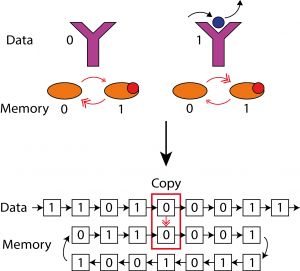Computational power of cells
How can molecular systems or cells be used to perform complex computational tasks? And what is the lowest amount of energy needed to execute such operations? Group leader Pieter Rein ten Wolde from AMOLF recently published two articles together with his colleague Thomas Ouldridge of the Imperial College London, in which they provide first clues on how to construct a biochemical system that is able to copy and transfer information in an energy efficient way.
Cells, like bacteria or cells in our bodies, are continuously processing information from their environment. To do so, they make use of biomolecules like proteins and DNA, which engage in chemical reactions. Are these reactions also able to perform computational tasks, comparable to computers? And if so, how efficient can these cellular computers ultimately be? Pieter Rein ten Wolde, group leader of the Biochemical Networks group at AMOLF, together with his colleague Thomas Ouldridge of the Imperial College London, investigated the theoretical framework for such cellular computers.
Copy states
In a first article, published on April 7, 2017, in Physical Review X, they show how a relatively simple molecular process that takes place inside living cells, can copy the state of a protein into another protein. In their theoretical analysis, the researchers focussed on a system that cells commonly employ to transmit external signals from the surface of the cell to their nucleus. Receptor proteins at the surface of the cell bind signalling molecules, for example food molecules. Only when a receptor molecule is bound to such a signalling molecule, a phosphate group is added to a downstream messenger protein that carries the signal into the nucleus. The state of the messenger protein thus reflects the state of the receptor protein, and has become a kind of copy.

Design recommendations
The article in Physical Review X shows that this kind of biochemical computational copying is fast and needs little energy. Furthermore, based on theoretical analysis of this system, the article provides a blueprint for building synthetic, energy efficient, copying systems inspired by nature.
Complex copies
In the second article, published on April 11, 2017, in Physical Review Letters, the researchers take the idea one step further. In this article, they consider the production of polymer copies. Such a copy process happens not only during DNA replication, needed for cell division, but also during protein synthesis. In the latter process, information present in one type of polymer – the DNA – is copied into that of another – the protein, much like copying text from one piece of paper onto another.
The better the copy, the higher the costs
From their analysis, the researchers conclude that such a complex copying process is only possible in systems which are continuously fed with new energy. This new insight could explain why until now no one has succeeded in making synthetic systems that persistently produce accurate copies, which is one of the requirements for artificial ‘life’. Finally, Ten Wolde and Ouldridge prove through theoretic modelling that the more accurate copies have to be, the more resources and energy their production requires.
References
Thomas E. Ouldridge,1 Christopher C. Govern, and Pieter Rein ten Wolde, The thermodynamics of computational copying in biochemical systems, Physical Review X 7 (2017)
Thomas E. Ouldridge and Pieter Rein ten Wolde, Fundamental Costs in the Production and Destruction of Persistent Polymer Copies, Physical Review Letters 118, (2017)


